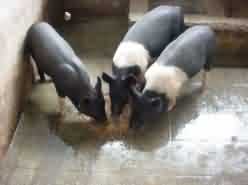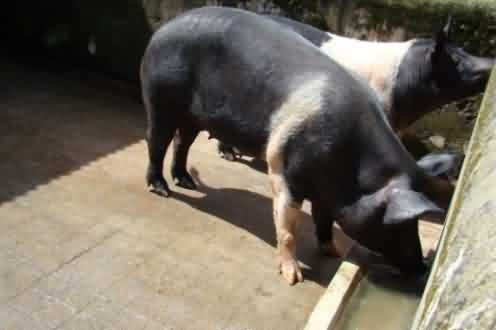सुअर की खुराक में फाइटेस सप्लीमेट का बेहतर तरीका और उसका महत्व
Pigs are monogastric has gastrointestinal tract relatively simple with three main compartments, the stomach, small and large intestine. The small intestine of the adult pigs is approximately 18 meters long.
The small and large intestine grow and completely develop and becomes functional only after 6-8 weeks of birth so why the weaning is required for piglet to digest fibrous and coarse feeds in better way.
The energy and protein are required in right proportion in the diet of pigs for proper utilization and further development of organs and productive performances. Energy and amino acids imbalance results in improper growth, poorer feed efficiency and low protein and fat deposition. Therefore, pigs are fed on balance diet in respect of protein together with appropriate amount of energy, minerals and vitamins to achieve best results (Table 1).
It is well-established facts that feed accounts for 70-75% of total cost of production. A common conventional diet of pig contains 60-80% cereal grains and its by-products, 20-40% vegetable protein supplements.
It is also fact that a good numbers of pig farrowed die before they reach market due to bad feeding and nutritional deficiency and it can only be achieved through balanced and nutritious feed.


Table 1: Important nutrient requirement for different categories of pig
| Nutrient | Creep Ration (5-10 kg) | Grower Ration | Finisher Ration | Adult Boar / Breeding Gilt | Lactating Gilt | |||
| 10-20 kg | 20-30 kg | 30-40 kg | 40-60 kg | 60-90 kg | ||||
|
Protein (%) |
20 | 16 | 16 | 14 | 14 | 14 | 12 | 13 |
|
Lysine (%) |
1.00 | 1.00 | 1.00 | 1.00 | 1.00 | 1.00 | 1.00 | 1.00 |
|
Methionine (%) |
0.30 | 0.30 | 0.30 | 0.30 | 0.30 | 0.30 | 0.30 | 0.30 |
|
Tryptophane (%) |
0.18 | 0.18 | 0.19 | 0.19 | 0.19 | 0.20 | 0.18 | 0.18 |
|
Digestible Energy (Kcal/kg) |
3400 | 3000 | 3000 | 3000 | 3000 | 3000 | 3400 | 3400 |
Calcium (%) |
0.80 | 0.60 | 0.60 | 0.60 | 0.50 | 0.50 | 0.75 | 0.75 |
Phosphorus (%) |
0.60 | 0.50 | 0.50 | 0.50 | 0.40 | 0.40 | 0.60 | 0.50 |
Common Salt (%) |
0.60 | 0.50 | 0.50 | 0.50 | 0.50 | 0.50 | 0.50 | 0.50 |
Swine rations are prepared as per the categories at different stages of growth and production as mentioned in table1. The creep ration is fed from suckling period to weaning age of high protein and energy.
The requirement of iron is more in piglets due to faster growth and sow milk alone cannot fulfill the requirement. In emergency cases, piglets can be fed cow’s milk by bottle-feeding otherwise skimmed milk fortified with minerals and vitamins are best sources of protein for the piglets.
The weaned piglets are switched over to grower ration when attained body weight of 10 kg and feed offered @ 1 kg/head/day during initial period and goes up to 1.5 kg/head/day during latter stages.
The cheaper feed resources should be taken to formulate economic ration. The pigs attained the body weight of 40 kg they are switched over to finisher ration. The pigs can eat 2 kg/head/day concentrate feed during early stages of these groups and it goes up to 2.5 kg/head/day at latter stages of body weight.
Swine Feeding system on locally available feedstuffs:
The eastern region of India is having in totality almost 50 percent of country’s pig population. These pigs are fed on locally available feedstuffs only. No special feed is offered even during various important physiological stages and thus it results in poor productive performance.
Some of the farmers are very unaware of the balance feeding benefit, some cannot afford due to cost and some due to unavailability. The regions also having an acute shortage of concentrate animal feed. Apart from this, pig is direct competitor of human beings in respect of food. Under such situation the available nutrients is inevitably bound to formulate ration for domestic non-ruminants involving minimum uses of cereal grain and maximum uses of agro-industrial by-products and other potential feedstuffs.
On the other hand, region roughly produces 3.84 million tonne rice milling by products which is almost 62.54% of total concentrate feed available in the region that sufficient to meet energy need of entire pig population.
Cereal by-products are important feed ingredients in Asia as a whole, but their efficient use in monogastric diets is hindered by the presence of high levels of non- starch polysaccharides and phytate.
Phytate is the major form of phosphorus (P) in cereal grains and oil seed meals and approximately 70% of the P is organically bound in the form of phytate which is a negatively charged ion that is able to bind cations and proteins and reduces its bioavailability due to lack of endogenous phytase enzyme in non-ruminants.
This low availability of phytate P poses two problems for pig and poultry farmers i.e. need to add inorganic phosphorus supplements to diet and excretion of large amount of phosphorus in the manure.
However, to improve the nutritive value of different available rice milling by-products with supplementation of phytase enzyme will be essential before their inclusion in swine and poultry ration for economical production and better results.
The studies revealed that crossbred pigs performed better even on maize or rice polish based balanced ration after fortification with vegetable protein and minerals (Table 2).
Similarly, the average daily gain was improved by 17% on addition of active phytase unit at 1.0 lac FTU/100kg diet in the ration of pigs at grower stage of growth with significant improvement in feed conversion ratio and nutrients digestibility (Table 3).
Table 2: Performance of crossbred pigs fed on maize and rice polish based ration
|
Ration composition (kg/100kg) |
Corn-rice polish-Soy Ration |
Corn-Soy Ration |
|
Maize |
30 |
80 |
|
Rice polish |
50 |
-- |
|
Soy meal |
17 |
17 |
|
Minerals and salt |
3 |
3 |
|
Post weaning stage |
||
|
Growth rate (g/day) |
175 |
189 |
|
Dry matter intake (g/day) |
464 |
456 |
|
Feed conversion ratio |
2.66 |
2.42 |
|
Grower stage |
||
|
Growth rate (g/day) |
372 |
406 |
|
Dry matter intake (g/day) |
1365 |
1336 |
|
Feed conversion ratio |
3.71 |
3.33 |
Table 3: Growth performance and nutrient digestibility in pigs fed on rice polish based ration supplemented with phytase enzyme
|
Particulars |
Diet-1 (without phytase at grower stage) |
Diet-2 (with 1 lac unit phytase at grower stage) |
|
Ingredient composition (kg/100kg) |
||
|
Rice polish |
50.00 |
50.00 |
|
Maize |
30.40 |
30.38 |
|
Protein feeds |
17.00 |
17.00 |
|
Lime |
1.50 |
1.50 |
|
Common salt |
1.00 |
1.00 |
|
Growth performance |
||
|
Initial body weight (kg) |
8.87 |
9.00 |
|
Av. Daily gain (g/d) |
387 |
453 |
|
Av. Feed intake (g/d) |
1305 |
1305 |
|
Feed conversion ratio |
3.37 |
2.88 |
|
Nutrient digestibility (%) |
||
|
Dry matter |
72.81 |
76.51 |
|
Crude protein |
69.59 |
73.12 |
|
Phosphorus |
37.61 |
52.25 |
Therefore, farmers are advisable to feed their pigs a balance ration made from available resources for better growth performance and economic return.
More importantly, the rations computed must be balanced in respect of energy and protein for profitable piggery as well as it is also recommended that diets containing rice polish at 50 percent level, phytase may be used at 1.0 lac FTU/100kg for better growth performance and nutrient digestibility.
Authors:
J.J. Gupta, A. Chakrabarti and A. Dey
Division of Livestock & Fishery Management
ICAR Research Complex for Eastern Region, Patna – 800014, Bihar (India)
E-mail:
